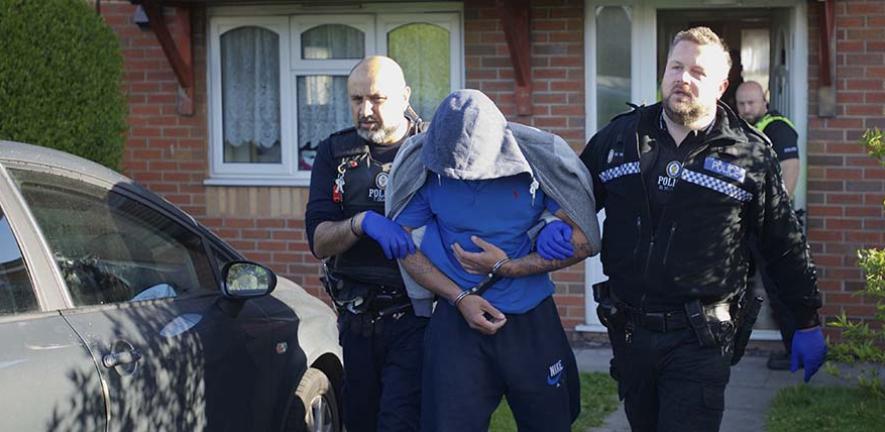
Researchers use over a decade of data from Thames Valley Police to reveal ‘mechanisms’ that generate and sustain violence within networks of organised crime.
Violence is like a virus, it spreads through proximity and familiarity
Paolo Campana
The first study to take a ‘network analysis’ approach to patterns of violence within UK organised crime gangs (OCG) has shown that OCG members who previously offended together are likely to end up attacking one another.
The research also reveals cycles of escalating violence within the criminal milieu of Thames Valley. For example, OCG members who harass other members are far more likely to become victims of violence, primarily from those they harassed.
Researchers found these ‘relational effects’ – whether one OCG member has worked with or fallen out with another – to be much stronger predictors of violent crime than more traditional ‘rap sheets’: prior offence lists of individuals.
The study, led by the University of Cambridge and using 16 years of data from Thames Valley Police, is published in the Journal of Quantitative Criminology. It marks an initial foray into ‘networks of violence’ research for the UK.
While network analyses have previously been used to help police some of the most violent cities in the USA, such as Chicago and Boston, this is the first time the technique has been deployed in a less violent European context.
“Our work shows the importance of taking relationships into account when developing policing risk factors and ‘red flags’,” said Dr Paolo Campana from Cambridge’s Institute of Criminology. “These techniques could help police identify at an earlier stage the social networks set to spiral into violence.”
Within the wider milieu of hardened OCG and all their known current and former associates, having co-offended – or been suspected of offending – with an OCG member dramatically increased the odds of becoming a victim of OCG violence by 56 times, typically from the former partner-in-crime.
Having harassed an OCG member or associate increased the odds of violent victimisation by a factor of 243, while those who had attacked someone in the network were 479 times more likely to become victims of violence themselves.
However, simply having a record of criminal violence, or of hard drugs offences, was found to have no significant effect on the potential for future violence.
Researchers say that such high odds ratios are due in part to limited data in this early study, but expect to see similarly strong correlations in future research. Campana is working with Cambridgeshire and Merseyside police to build bigger datasets.
“It often comes down to tit-for-tat retaliation that generates circuits of violence,” said Campana.
“In the Thames Valley data we can see how prior co-offending relationships turn sour and become a mechanism for further violence. Harassment within criminal networks also dramatically increases the potential for violence.”
“Violence is like a virus, it spreads through proximity and familiarity. Those within certain social bubbles are most at risk. In some US cities, co-offending bubbles account for over 80% of the violence,” he said.
“As we collect more data, we can expect to identify more of the chains and feedback loops that sustain violence and render it endemic within groups and locations.”
The study used anonymised records from Thames Valley Police between 2000 and 2016 to build a network model for organised crime across a population of just over two million, including cities such as Oxford and Reading.
Definitions of an OCG member includes those working with others to ‘commit serious crime on a continuing basis’, with elements of planning, structure and coordination.
Campana and his colleague Dr Nynke Niezink from Carnegie Mellon University in the USA analysed a criminal environment of 6,234 individuals, of which 833 were longstanding OCG: active as part of a gang for two years both before and after their first and last recorded offences.
Overall, belonging to an OCG carried a slightly lower risk of becoming a victim of violence than those in the wider criminal network, but it increased the risk of being attack by fellow gang members.
Researchers whittled over 23,000 events down to 156 OCG-instigated violent acts with sufficient data on the connections and criminal histories of the gang members involved.
Acts included murder and attempted murder, manslaughter, assault, and actual and grievous bodily harm with and without intent. Related incidents of threats and harassment were added to data models in addition to core acts of violence.
The hardened OCG members were overwhelmingly male (93%), and most had been active in drug dealing. Half (51%) had been involved in a violent act, while a quarter (26%) had been a victim of violence.
The few female OCG members were twice as likely as male members to be victims of violence. This was despite researchers removing incidents related to domestic violence.
Police initially supplied records on all events involving at least one OCG member as offender or victim, along with information on all others connected to the event.
Over the data period, the average size of a crime gang in Thames Valley’s jurisdiction – which includes cities such as Oxford and Reading – was 5-6 members, with the largest composed of 21 members.

The text in this work is licensed under a Creative Commons Attribution 4.0 International License. Images, including our videos, are Copyright ©University of Cambridge and licensors/contributors as identified. All rights reserved. We make our image and video content available in a number of ways – as here, on our main website under its Terms and conditions, and on a range of channels including social media that permit your use and sharing of our content under their respective Terms.